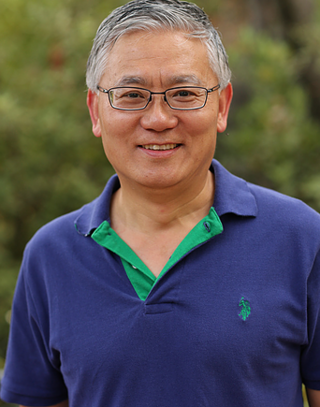Collaborative software or groupware is application software designed to help people working on a common task to attain their goals. One of the earliest definitions of groupware is "intentional group processes plus software to support them."
Computer-supported cooperative work (CSCW) is the study of how people utilize technology collaboratively, often towards a shared goal. CSCW addresses how computer systems can support collaborative activity and coordination. More specifically, the field of CSCW seeks to analyze and draw connections between currently understood human psychological and social behaviors and available collaborative tools, or groupware. Often the goal of CSCW is to help promote and utilize technology in a collaborative way, and help create new tools to succeed in that goal. These parallels allow CSCW research to inform future design patterns or assist in the development of entirely new tools.
Awareness in philosophy and psychology is a concept about knowing, perceiving and being cognizant of events. Another definition describes it as a state wherein a subject is aware of some information when that information is directly available to bring to bear in the direction of a wide range of behavioral actions. The concept is often synonymous to consciousness and is also understood as being consciousness itself.

In human–computer interaction, WIMP stands for "windows, icons, menus, pointer", denoting a style of interaction using these elements of the user interface. Other expansions are sometimes used, such as substituting "mouse" and "mice" for menus, or "pull-down menu" and "pointing" for pointer.
In computing, post-WIMP comprises work on user interfaces, mostly graphical user interfaces, which attempt to go beyond the paradigm of windows, icons, menus and a pointing device, i.e. WIMP interfaces.
Group information management (GIM) is an extension of personal information management (PIM) "as it functions in more public spheres" as a result of peoples' efforts to share and co-manage information, and has been a topic of study for researchers in PIM, human–computer interaction (HCI), and computer supported cooperative work (CSCW). People acquire, organize, maintain, retrieve and use information items to support individual needs, but these PIM activities are often embedded in group or organizational contexts and performed with sharing in mind. The act of sharing moves personal information into spheres of group activity and also creates tensions that shape what and how the information is shared. The practice and the study of GIM focuses on this interaction between personal information and group contexts.
W. Keith Edwards is a professor in the School of Interactive Computing at the Georgia Institute of Technology and Director of the GVU Center at Georgia Tech.

GroupLens Research is a human–computer interaction research lab in the Department of Computer Science and Engineering at the University of Minnesota, Twin Cities specializing in recommender systems and online communities. GroupLens also works with mobile and ubiquitous technologies, digital libraries, and local geographic information systems.

Human–computer interaction (HCI) is research in the design and the use of computer technology, which focuses on the interfaces between people (users) and computers. HCI researchers observe the ways humans interact with computers and design technologies that allow humans to interact with computers in novel ways. A device that allows interaction between human being and a computer is known as a "Human-computer Interface (HCI)".

The DiamondTouch table is a multi-touch, interactive PC interface product from Circle Twelve Inc. It is a human interface device that has the capability of allowing multiple people to interact simultaneously while identifying which person is touching where. The technology was originally developed at Mitsubishi Electric Research Laboratories (MERL) in 2001 and later licensed to Circle Twelve Inc in 2008. The DiamondTouch table is used to facilitate face-to-face collaboration, brainstorming, and decision-making, and users include construction management company Parsons Brinckerhoff, the Methodist Hospital, and the US National Geospatial-Intelligence Agency (NGA).
Alice Jane Bernheim Brush is an American computer scientist known for her research in human-computer interaction, ubiquitous computing and computer supported collaborative work (CSCW). She is particularly known for her research studying and building technology for homes as well as expertise conducting field studies of technology. She is the co-chair of CRA-W from 2014 to 2017.
Victoria Bellotti is a Senior CI researcher in the Member Experience Team at Netflix. Previously, she was a user experience manager for growth at Lyft and a research fellow at the Palo Alto Research Center. She is known for her work in the area of personal information management and task management, but from 2010 to 2018 she began researching context-aware peer-to-peer transaction partner matching and motivations for using peer-to-peer marketplaces which led to her joining Lyft. Victoria also serves as an adjunct professor in the Jack Baskin School of Engineering at University of California Santa Cruz, on the editorial board of the Personal and Ubiquitous Computing and as an associate editor for the International Journal of HCI. She is a researcher in the Human–computer interaction community. In 2013 she was awarded membership of the ACM SIGCHI Academy for her contributions to the field and professional community of human computer interaction.

Projector-camera systems (pro-cam), also called camera-projector systems, augment a local surface with a projected captured image of a remote surface, creating a shared workspace for remote collaboration and communication. Projector-camera systems may also be used for artistic and entertainment purposes. A pro-cam system consists of a vertical screen for implementing interpersonal space where front-facing videos are displayed, and a horizontal projected screen on the tabletop for implementing shared workspace where downward facing videos are overlapped. An automatically pre-warped image is sent to the projector to ensure that the horizontal screen appears undistorted.
Animal–computer interaction (ACI) is a field of research for the design and use of technology with, for and by animals covering different kinds of animals from wildlife, zoo and domesticated animals in different roles. It emerged from, and was heavily influenced by, the discipline of Human–computer interaction (HCI). As the field expanded, it has become increasingly multi-disciplinary, incorporating techniques and research from disciplines such as artificial intelligence (AI), requirements engineering (RE), and veterinary science.
Feminist HCI is a subfield of human-computer interaction (HCI) that applies feminist theory, critical theory and philosophy to social topics in HCI, including scientific objectivity, ethical values, data collection, data interpretation, reflexivity, and unintended consequences of HCI software. The term was originally used in 2010 by Shaowen Bardzell, and although the concept and original publication are widely cited, as of 2020 Bardzell's proposed frameworks have been rarely used since.

Wendy Elizabeth Mackay is a Canadian researcher specializing in human-computer interaction. She has served in all of the roles on the SIGCHI committee, including Chair. She is a member of the CHI Academy and a recipient of a European Research Council Advanced grant. She has been a visiting professor in Stanford University between 2010 and 2012, and received the ACM SIGCHI Lifetime Service Award in 2014.
Carl Gutwin is a Canadian computer scientist, professor and the director of the Human–computer interaction (HCI) Lab at the University of Saskatchewan. He is also a co-theme leader in the SurfNet research network and was a past holder of a Canada Research Chair in Next-Generation Groupware. Gutwin is known for his contributions in HCI ranging from the technical aspects of systems architectures, to the design and implementation of interaction techniques, and to social theory as applied to design. Gutwin was papers co-chair at CHI 2011 and was a conference co-chair of Computer Supported Cooperative Work (CSCW) 2010.
Joëlle Coutaz is a French computer scientist, specializing in human-computer interaction (HCI). Her career includes research in the fields of operating systems and HCI, as well as being a professor at the University of Grenoble. Coutaz is considered a pioneer in HCI in France, and in 2007, she was awarded membership to SIGCHI. She was also involved in organizing CHI conferences and was a member on the editorial board of ACM Transactions on Computer-Human Interaction.
Susanne Bødker is a Danish computer scientist known for her contributions to human–computer interaction, computer-supported cooperative work, and participatory design, including the introduction of activity theory to human–computer interaction. She is a professor of computer science at Aarhus University, and a member of the CHI Academy.

Shumin Zhai is a Chinese-born American Canadian Human–computer interaction (HCI) research scientist and inventor. He is known for his research specifically on input devices and interaction methods, swipe-gesture-based touchscreen keyboards, eye-tracking interfaces, and models of human performance in human-computer interaction. His studies have contributed to both foundational models and understandings of HCI and practical user interface designs and flagship products. He previously worked at IBM where he invented the ShapeWriter text entry method for smartphones, which is a predecessor to the modern Swype keyboard. Dr. Zhai's publications have won the ACM UIST Lasting Impact Award and the IEEE Computer Society Best Paper Award, among others, and he is most known for his research specifically on input devices and interaction methods, swipe-gesture-based touchscreen keyboards, eye-tracking interfaces, and models of human performance in human-computer interaction. Dr. Zhai is currently a Principal Scientist at Google where he leads and directs research, design, and development of human-device input methods and haptics systems.






